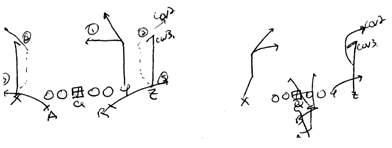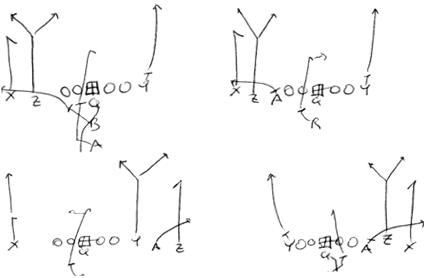Curl/Corner Read:

The infamous "curl/corner" read, shown above, has been around a long time. Currently, coaches like Charlie Weis, formerly with the Patriots and now with Notre Dame, Petrino at the University of Louisville, and Steve Spurrier have use this a lot. I already diagrammed some of the route's mechanics regarding Spurrier here.
Deep Choice:
An intriguing combination is the "deep choice" which combines a 3-level Cover 3 beater to one side with a Cover 2 beater by letting the slot or tight-end read MOFO/MOFC and run either a corner route or a post. The QB then adjusts his progression depending on MOFO or MOFC.

On the right is how Petrino at Louisville uses it, getting a corner/flat read against Cover 2, and on the left is how Weis likes to use it, instead getting a similar effect to the "Texas" concept used by many West Coast offense teams.
Choice Route:
If there is no deep middle safety, the "choice" receiver will plant at 10-12 and drive for the goal post, looking for the ball over his inside shoulder. If there is a deep middle safety, he will stick his inside foot at 10-12 and break for the corner at a depth of 22-25 yards. The outside receiver runs a curl at 12 yards.
Louisville Version:

The Louisville version is the simplest. If the middle of the field is closed (or there is 1-high) the QB will look for the corner first, then the curl, then to the flat to the strongside. The curl will look to slide a bit inside the first flat defender. Basically, if the cornerback retreats with the corner route, then the QB has a simple curl/flat read.
Against MOFO, the QB looks (1) to the deep post route, (2) to the corner route, and (3) to the flat (sometimes it is a hitch route). This is a basic hi/lo read, and he should be able to hit the post or the corner route for a significant gain.
The Weis version:

Against cover 3/MOFC, the route is read exactly the same (1-corner, 2-curl, 3-flat). Against MOFO it becomes like Texas, in that the QB is high/low'ing the Mike or middle linebacker rather than the outside cornerback. The QB looks for the post first: if the Mike squats or does not retreat fast enough, the QB must get it over his head and throw it to the post, splitting the safeties; if Mike drops fast (in the "Tampa 2" defense made popular by Tony Dungy, the Mike linebacker drops back so far and quickly he becomes like a deep middle safety) the QB wants to look for the RB over the middle on either a quick cross or an angle route, as shown above.
If Mike drops deep to cover the post but Sam (strongside outside linebacker) collapses on the RB, then the curl should be open late, as he slides into the QB's vision and the open space.
Conclusion:
While "reading on the fly" appears difficult to do, the routes shown above have only a key or two and have proven to be effective at many levels, including High School. The godfather of all "reading passing games" is of course the run and shoot (see link for details of its routes against different coverages), and while no major college or pro team uses it in its full form, these routes show its lasting impact and that much can be learned from its six or seven basic plays.

Tidak ada komentar:
Posting Komentar